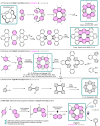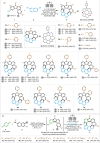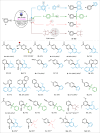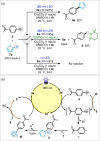Electrochemical cascade access to hetero[8]circulenes as potent organophotocatalysts for diverse C-X bond formations
- PMID: 40593683
- PMCID: PMC12216941
- DOI: 10.1038/s41467-025-60889-w
Electrochemical cascade access to hetero[8]circulenes as potent organophotocatalysts for diverse C-X bond formations
Abstract
The chemistry of hetero[8]circulenes has been limited to three main types, constrained by synthetic challenges in creating unsymmetrical variants. Herein, we introduce an electrochemical approach to a type of hetero[8]circulene, featuring five hexagons and three pentagons. Our method capitalizes on the sustainability and selectivity of electrochemistry, utilizing differential oxidation potentials to generate dioxaza[8]circulenes through selective intermolecular and intramolecular couplings under mild conditions, achieving yields of up to 83% with good functional group tolerance. We further refine this process into a one-pot protocol using commercially available substrates, forming six new bonds. Comprehensive structural, optical, and electrochemical characterizations, including X-ray crystallography, spectrophotometric analysis, and DFT calculations, are conducted. Inspired by their distinct structural and redox properties, we explore the application of dioxaza[8]circulenes as organophotocatalysts for diverse C-X (X = C, B, S, P) bond formation achieving up to 97% yields under LED light irradiation (365 nm) without transition metals.
© 2025. The Author(s).
Conflict of interest statement
Competing interests: The authors declare no competing interests.
Figures





Similar articles
-
Organic Synthesis Away from Equilibrium: Contrathermodynamic Transformations Enabled by Excited-State Electron Transfer.Acc Chem Res. 2024 Jul 2;57(13):1827-1838. doi: 10.1021/acs.accounts.4c00227. Epub 2024 Jun 21. Acc Chem Res. 2024. PMID: 38905487 Free PMC article.
-
Factors that influence parents' and informal caregivers' views and practices regarding routine childhood vaccination: a qualitative evidence synthesis.Cochrane Database Syst Rev. 2021 Oct 27;10(10):CD013265. doi: 10.1002/14651858.CD013265.pub2. Cochrane Database Syst Rev. 2021. PMID: 34706066 Free PMC article.
-
Signs and symptoms to determine if a patient presenting in primary care or hospital outpatient settings has COVID-19.Cochrane Database Syst Rev. 2022 May 20;5(5):CD013665. doi: 10.1002/14651858.CD013665.pub3. Cochrane Database Syst Rev. 2022. PMID: 35593186 Free PMC article.
-
Hydrogen Atom Transfer Promoted by Carbon-Centered Biradicals via Energy Transfer Catalysis.Acc Chem Res. 2025 Jul 1;58(13):2028-2045. doi: 10.1021/acs.accounts.5c00228. Epub 2025 Jun 9. Acc Chem Res. 2025. PMID: 40490849
-
Neuraminidase inhibitors for preventing and treating influenza in healthy adults and children.Cochrane Database Syst Rev. 2012 Jan 18;1:CD008965. doi: 10.1002/14651858.CD008965.pub3. Cochrane Database Syst Rev. 2012. Update in: Cochrane Database Syst Rev. 2014 Apr 10;(4):CD008965. doi: 10.1002/14651858.CD008965.pub4. PMID: 22258996 Updated.
References
-
- Hensel, T., Andersen, N. N., Plesner, M. & Pittelkow, M. Synthesis of heterocyclic[8]circulenes and related structures. Synlett27, 498–525 (2016).
-
- Stępień, M., Gońka, E., Żyła, M. & Sprutta, N. Heterocyclic nanographenes and other polycyclic heteroaromatic compounds: Synthetic routes, properties, and applications. Chem. Rev.117, 3479–3716 (2017). - PubMed
-
- Miyake, Y. & Shinokubo, H. Hetero[8]circulenes: Synthetic progress and intrinsic properties. Chem. Commun.56, 15605–15614 (2020). - PubMed
Grants and funding
LinkOut - more resources
Full Text Sources

